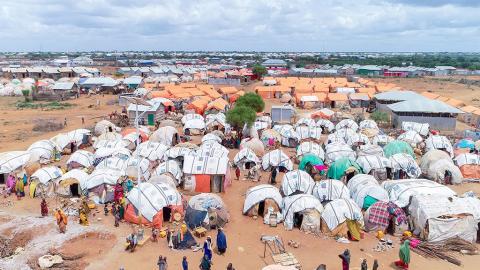Radical exclusion among the most vulnerable
Millions of forced internally displaced persons already live de facto in humanitarian crises and on the survival line. With Covid-19, there is only a more uncertain and precarious outlook.
- Opinión

The Forced Internally Displaced Persons, massive, structural and global processes
The main characteristic of Internal Forced Displacement is non-voluntary and forced mobility of populations within the internal borders of a country. In addition, it has multiple causes, from various environmental disasters (storms, cyclones, floods, droughts, landslides, earthquakes, etc.), to human processes related to violence, such as conflicts, wars, megaprojects, etc., [1]. Generally, this form of forced human spatial mobility involves various human rights violations (especially when caused by violence or conflict), and currently affects tens of millions of people in many countries of the world.
According to the most recent report of the Internal Displacement Monitoring Center, in 2019 the displaced persons were 33.4 million, of which 8.5 million were related to conflict and violence, and 24.9 million to different environmental disasters [2]. This number is the highest since 2012. And, if the people affected in 2019 are added to those of previous recent years, the total number of internally displaced people whose lives have been impacted, the figure rises to approximately 50.8 million [3]. The number of Forced Internally Displaced Persons is much higher than the number of refugees outside their countries (which currently stands at around 26 million) [4].
Although it is a dynamic with global dimensions, there are places, regions and countries that are much more affected by the processes of forced internal displacement than others. The main regions impacted by these forced mobilities are South Asia (with 30% of the total) and Sub-Saharan Africa (with 24.1%). After, and far behind the previously mentioned regions, there is the Middle East and North Africa (with 9.6%). And, with much less affected population, there are America (with 6.1%) and, finally, Europe (with 0.3%) [5]. And, at the national state level, some of the most affected countries are Syria, the Democratic Republic of the Congo, Ethiopia and South Sudan.
Internally Displaced Persons in the Context of the COVID Pandemic 19
Forced internally displaced persons already face very adverse and complicated conditions. Not only many of them abruptly lost their homes and communities, but also their work, their means of earning a living, and their material heritage. Furthermore, many of them, especially those affected by conflicts and contexts of violence, do not have the right to health, nor to education, and even less to security; reason why the possibility of a worthy and full existence is canceled for them. But now, and in the context of the COVID 19 Pandemic and its global effects in multiple areas (economic, social, labor), their situation will most likely further deteriorate and be affected by various processes:
1) First, due to their living conditions (characterized by being concentrated / confined and in physical contiguity in displaced persons camps and in provisional places), displaced persons are exposed to outbreaks of contagion where the disease spreads very fast and massively [6].
2) Likewise, considering that they have severe nutritional and sanitary deficiencies, the health situation of an important part of the internally displaced persons was and is precarious. De facto, virus containment and prevention measures (physical isolation, use of antibacterial gel, and frequent hand washing) are not possible in many places where displaced persons temporarily live [7]. Thus, it is a population even more exposed to COVID 19.
3) This, in addition, is accentuated if we consider the specific population groups of the internally displaced persons who are already highly vulnerable (pregnant women, the elderly, people with diseases such as obesity, hypertension, respiratory infections and diabetes). These population groups are even more at risk.
4) In addition to the above, given their life situations and little access to health services, they have little real chance of having specialized medical attention and sufficient in case of infection and illness. If an outbreak occurs in some of the sites of the displaced, a catastrophic and difficult to control situation looms [8].
5) No less important, the economic impacts of the COVID 19 pandemic at the national, regional and global levels will have severe repercussions on internally displaced groups and their current life situations. Not only will it become more difficult to obtain jobs and generate survival strategies for them. The economic amounts for national and international programs and policies destined to care for the population affected by processes of forced internal displacement will also surely decrease.
Many of the millions of forced internally displaced persons already live de facto in humanitarian crises and on the survival line. And, now, there is only a more uncertain and precarious outlook.
Notes
[1] https://www.jornada.com.mx/sin-fronteras/2020/04/28/se-dispara-cifra-de-desplazados-internos-en-el-mundo-4851.html y https://www.internal-displacement.org/sites/default/files/publications/documents/2020-IDMC-GRID-executive-summary.pdf
[4] https://www.jornada.com.mx/sin-fronteras/2020/04/28/se-dispara-cifra-de-desplazados-internos-en-el-mundo-4851.html[4] https://www.jornada.com.mx/sin-fronteras/2020/04/28/se-dispara-cifra-de-desplazados-internos-en-el-mundo-4851.html
Del mismo autor
- Forced internal displacement in Mexico and processes of violence 13/03/2022
- Labor struggles against precarious work and agribusiness exploitation 09/01/2022
- Detentions, deportations, and criminalization of migrants 29/11/2021
- México: detenciones, deportaciones y criminalización de los migrantes 15/11/2021
- Visibility of migrant voices and subjects 18/10/2021
- La decolonialidad y el abordaje de las movilidades humanas transfronterizas 01/10/2021
- Migrants, social organizations, and policies to control cross-border mobility 20/09/2021
- Decoloniality and sense of the production of social knowledge 06/09/2021
- Decolonialidad y sentido de la producción de conocimiento social 26/08/2021
- México: migrantes, organizaciones sociales y políticas del control de las movilidades transfronterizas 09/08/2021
